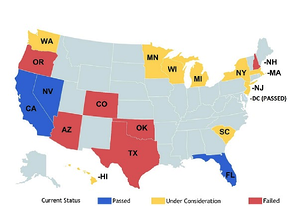 Driving would be so much easier if the car drove itself. Also safer and more efficient – no falling asleep at the wheel; no tailgating drivers creeping up on you, or fender-benders that cause traffic tie-ups. Also, no more jack-rabbit starts and slam-on-the-brakes stops, which waste fuel. So far, they’re just in the testing phase, but driverless cars could be the future of personal transportation, and a few states are getting ready for them.
Driving would be so much easier if the car drove itself. Also safer and more efficient – no falling asleep at the wheel; no tailgating drivers creeping up on you, or fender-benders that cause traffic tie-ups. Also, no more jack-rabbit starts and slam-on-the-brakes stops, which waste fuel. So far, they’re just in the testing phase, but driverless cars could be the future of personal transportation, and a few states are getting ready for them.
In 2012, California took a step toward the future by signing into law Senate Bill 1298, which authorizes the operation of autonomous vehicles on public roads for testing purposes and directs the state’s department of transportation to adopt regulations related to autonomous vehicle operation by 2015.
Since California took action, Washington, DC, Florida (here and here), and Nevada have passed similar legislation, with 15 more states (see map) considering legislation (of those, six did not pass the bills in this year’s session). Florida and Nevada have taken the further step of lifting their bans on texting for these vehicles when operated in “autonomous” mode.
State legislation differs in specifics, but generally addresses a few critical issues:
- Definition of autonomous vehicles
- Provisions for liability in the event of an accident
- Limitation to test vehicle operation on public roads
- Instruction to transportation regulatory group or commission to investigate regulatory barriers and propose a regulatory structure
In May, the National Highway Traffic Safety Administration issued its first policy on “automated vehicles,” in which it addressed not only fully driverless vehicles but also various technologies, such as “crash avoidance” and vehicle-to-vehicle communication systems, which move toward vehicle automation.
“Although this Statement focuses on the enormous safety potential of these new technologies, they offer an even wider range of possible benefits,” wrote the NHTSA. “Vehicle control systems that automatically accelerate and brake with the flow of traffic can conserve fuel more efficiently than the average driver. By eliminating a large number of vehicle crashes, highly effective crash avoidance technologies can reduce fuel consumption by also eliminating the traffic congestion that crashes cause every day on our roads. Reductions in fuel consumption, of course, yield corresponding reductions in greenhouse gas emissions. To the extent vehicles can communicate with each other and with the highway infrastructure, the potential for safer and more efficient driving will be increased even more.”
The NHTSA policy also provided guidance to states, urging them to authorize driverless vehicles for testing only, at this stage of technology development. But that caution did not blunt the agency’s enthusiasm for the potential of automated vehicles. “While the agency does not believe that self-driving vehicles are currently ready to be driven on public roads for purposes other than testing, the agency would like to emphasize that it is encouraged by innovations in automated driving and their potential to transform our roadways.”
Google has gotten the most attention for their work on driverless car technology, and the company was the driving force behind the California legislation, but a number of other companies and academic institutions are also actively working on the driverless car around the world. Carnegie Mellon University in Pittsburgh is piloting a project in partnership with General Motors that is well into testing phase.
Check out this video of a Google driverless car test drive:
Driverless cars offer a transformative technology that has the potential to dramatically impact daily life for people around the world and spark broad scale innovation in the transportation sector. Driverless cars require constant automated monitoring of activities around the vehicle and programmed responses to ensure safe transport. Communications technologies are certain to find potential markets in fixed transportation infrastructure (such as lane dividers, traffic lights and stop signs), but also potentially with inter-car communications and fueling/charging infrastructure.
Some experts caution that automatic vehicles have their limits. While much of the operation of driving may be mechanical, they say, in crisis situations there is no substitute for human decision-making. Ryan Calo, a law professor at the University of Washington who co-founded Stanford’s Legal Aspects of Autonomous Driving center, told the New York Times, “The first time that a driverless vehicle swerves to avoid a shopping cart and hits a stroller, someone’s going to write, ‘robot car kills baby to save groceries.’”
Test vehicles are required to have a human override, but Google anticipates future vehicles may operate entirely in autonomous mode.
From an energy perspective, driverless cars may be programmed to operate at optimum efficiency. From a social perspective, driverless cars extend independent mobility to the blind, elderly, young and others who are currently dependent upon others and a social network for services. From a safety perspective, advocates claim the removal of human error offers the opportunity to avoid thousands of car-related deaths each year as well as a way to take inebriated or otherwise impaired drivers from behind the wheel.
Technology is currently in testing phase and will be for many years – but, already Google claims to have logged a half a million miles of testing without incident, as Google employees have tested the vehicles in their daily commutes.
